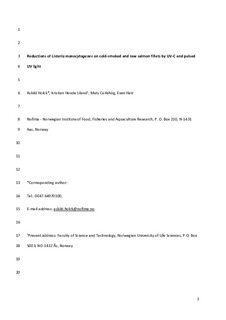| dc.contributor.author | Holck, Askild Lorentz | |
| dc.contributor.author | Liland, Kristian Hovde | |
| dc.contributor.author | Carlehög, Mats | |
| dc.contributor.author | Heir, Even | |
| dc.date.accessioned | 2019-02-20T08:21:12Z | |
| dc.date.available | 2019-02-20T08:21:12Z | |
| dc.date.created | 2018-12-10T16:51:50Z | |
| dc.date.issued | 2018 | |
| dc.identifier.citation | Innovative Food Science & Emerging Technologies. 2018, 50 1-10. | |
| dc.identifier.issn | 1466-8564 | |
| dc.identifier.uri | http://hdl.handle.net/11250/2586408 | |
| dc.description.abstract | Salmon is the food most frequently reported in the RASFF (Rapid Alert System for Food and Feed) database in conjunction with Listeria monocytogenes and consumption of cold-smoked salmon have led to severe outbreaks of listeriosis infections. UV-C and pulsed UV light were investigated for their ability to reduce L. monocytogenes on salmon. Cold-smoked and raw salmon were spiked with a mix of ten L. monocytogenes strains (104 CFU/sample) and subsequently exposed to UV-C light (0.0075–0.6 J/cm2) or high intensity pulsed UV light (1.3–10.8 J/cm2). Reductions of L. monocytogenes on smoked salmon were 0.7–1.3 log, depending on the fluence. Corresponding reductions for raw salmon muscle side and skin side were 0.2–0.9 log and 0.4–1.1 log, respectively. Generally, reductions using UV-C and pulsed UV light were within the same range, but with some treatments statistically different. L. monocytogenes surviving UV treatments on smoked and raw salmon grew at the same rate as controls during storage at 4 °C, but reached the levels of the controls 13 and 7 days later, respectively. No sensory changes were detected in UV-C treated (0.05 J/cm2) smoked salmon. | |
| dc.language.iso | eng | |
| dc.subject | Listeria monocytogenes | |
| dc.subject | Laks | |
| dc.subject | Atlantic salmon | |
| dc.subject | Microbial decontamination | |
| dc.subject | UV light | |
| dc.title | Reductions of Listeria monocytogenes on cold-smoked and raw salmon fillets by UV-C and pulsed UV light | |
| dc.type | Peer reviewed | |
| dc.type | Journal article | |
| dc.description.version | submittedVersion | |
| dc.source.pagenumber | 1-10 | |
| dc.source.volume | 50 | |
| dc.source.journal | Innovative Food Science & Emerging Technologies | |
| dc.identifier.doi | 10.1016/j.ifset.2018.10.007 | |
| dc.identifier.cristin | 1641342 | |
| dc.relation.project | Fiskeri- og havbruksnæringens forskningsfond: 901166 | |
| dc.relation.project | Nofima AS: 10333 | |
| dc.relation.project | Norges forskningsråd: 221663 | |
| dc.relation.project | Nofima AS: 11545 | |
| dc.relation.project | Norges forskningsråd: 262306 | |
| dc.relation.project | Nofima AS: 201704 | |
| cristin.unitcode | 7543,3,4,0 | |
| cristin.unitcode | 7543,3,2,0 | |
| cristin.unitcode | 7543,3,3,0 | |
| cristin.unitname | Trygg og holdbar mat | |
| cristin.unitname | Råvare og prosess | |
| cristin.unitname | Sensorikk, forbruker og innovasjon | |
| cristin.ispublished | true | |
| cristin.fulltext | preprint | |
| cristin.qualitycode | 1 | |
